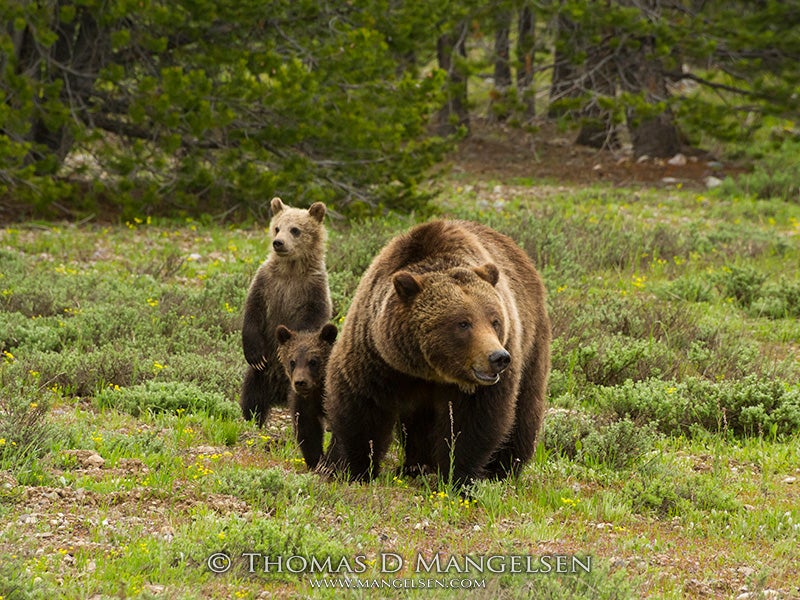Groups Challenge Decision to Remove Yellowstone Grizzly Protections
Delisting defies best available science, sidesteps important legal safeguards
Contact
A coalition of tribal and conservation interests today filed a lawsuit in federal court seeking to restore critical protections to the Yellowstone region’s iconic grizzly bears before new threats, including hunting, push the population further into decline.
Today’s suit challenges a June 2017 decision by the U.S. Fish and Wildlife Service to remove the Yellowstone-area grizzly population from the list of species protected by the Endangered Species Act, which enables the states of Idaho, Montana, and Wyoming to move ahead with plans for trophy hunting of grizzlies.
Courtesy of Thomas D. Mangelsen
First light strikes the summit of Mount Moran painting the sky orange as a female grizzly wades a shallow bend in the Snake River in Grand Teton National Park, Wyoming. See more photos
The Fish and Wildlife Service’s decision came despite a recent increase in grizzly deaths in the Yellowstone region following the demise of some of the bears’ key food sources, including the seeds of whitebark pine. Federal biologists documented a record-high 61 grizzly deaths in 2015 and 58 in 2016, with the majority of those caused by people. As a result, the government’s own estimate of the Yellowstone grizzly population level has declined from 757 in 2014 to 695 in 2016.
“With grizzly deaths spiking and the population in apparent decline, the Yellowstone population needs continued protection, not a new threat of state-sponsored trophy hunting,” said Earthjustice attorney Timothy Preso. “The grizzly is a major part of what makes the region in and around Yellowstone National Park so special and unique. We should not be taking a gamble with the grizzly’s future.”
Earthjustice is representing the Northern Cheyenne Tribe, Sierra Club, Center for Biological Diversity, and National Parks Conservation Association in taking legal action to protect the grizzly bear as the Endangered Species Act requires. The coalition’s legal challenge takes issue with the Service’s evaluation of the mortality consequences of the bears’ recent shift to a more heavily meat-based diet following the loss of other foods. It also faults the agency for surgically delisting the isolated Yellowstone grizzly population instead of focusing on a broader, more durable grizzly recovery in the West.
“Without continued Endangered Species Act protections, the recovery of grizzly bears in Greater Yellowstone is in serious jeopardy. Inadequate requirements to protect and connect Yellowstone grizzlies to other populations and hostile state management policies will mean fewer bears restricted to an even smaller area. Grizzly bears will be killed through trophy hunts on the doorstep of Yellowstone and Grand Teton National Parks instead of inspiring millions who come to the region just for a chance to see a live grizzly bear in the wild,” said Bonnie Rice, Greater Yellowstone senior representative with Sierra Club’s Our Wild America campaign.
“These iconic bears need to be protected, not gunned down so their heads can go on some trophy hunter’s wall,” said Andrea Santarsiere, a senior attorney with the Center for Biological Diversity. “Facing ongoing threats and occupying less than five percent of their historic range, grizzly bears are nowhere near recovery and continue to need the strong protections of the Endangered Species Act.”
“National Parks Conservation Association refutes the Department of the Interior’s short-sighted decision, which threatens Yellowstone grizzlies and ignores concerns, including those raised by many in the National Park Service. Despite Interior’s claim, the long-term health of Yellowstone and Grand Teton grizzlies is far from certain,” added Stephanie Adams, Yellowstone Program Manager for National Parks Conservation Association. “We must ensure Yellowstone grizzlies have necessary protections in place for the population to thrive.”
Background
Since 1975, Yellowstone-area grizzly bears have been listed as threatened under the Endangered Species Act. Federal biologists acknowledge that population growth of the Yellowstone grizzly bear has flattened over the past decade and their own data indicates a decline from 2014 to 2016. Prior to and during that same period, the grizzly population has faced the loss of two of its most important food sources in the Yellowstone region—whitebark pine seeds and cutthroat trout—due to changing environmental conditions driven in part by a warming climate.
In the wake of these changes, scientists have documented the bears’ transition to a more meat-based diet, but that diet leads to a greater potential for conflict with humans as bears seeking meat interact with hunters and ranchers. Nevertheless, the Fish and Wildlife Service in June 2017 finalized a decision to remove the Yellowstone grizzly population from the threatened species list, claiming that the bear population is recovered.
The Service previously attempted to delist the Yellowstone grizzly population in 2007, but that decision was overturned by a federal district court in Montana along with the 9th Circuit Court of Appeals on the basis that the Service ignored the impacts of the whitebark pine loss on the grizzly population. In rejecting the Service’s 2007 grizzly delisting decision, the 9th Circuit admonished the agency that “the Service cannot take a full-speed ahead, damn-the-torpedoes approach to delisting—especially given the ESA’s ‘policy of institutionalized caution.’”

Additional Resources
About Earthjustice
Earthjustice is the premier nonprofit environmental law organization. We wield the power of law and the strength of partnership to protect people's health, to preserve magnificent places and wildlife, to advance clean energy, and to combat climate change. We are here because the earth needs a good lawyer.